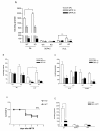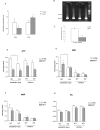Lack of neuroprotection in the absence of P2X7 receptors in toxin-induced animal models of Parkinson's disease
- PMID: 21542899
- PMCID: PMC3113297
- DOI: 10.1186/1750-1326-6-28
Lack of neuroprotection in the absence of P2X7 receptors in toxin-induced animal models of Parkinson's disease
Abstract
Background: Previous studies indicate a role of P2X7 receptors in processes that lead to neuronal death. The main objective of our study was to examine whether genetic deletion or pharmacological blockade of P2X7 receptors influenced dopaminergic cell death in various models of Parkinson's disease (PD).
Results: mRNA encoding P2X7 and P2X4 receptors was up-regulated after treatment of PC12 cells with 1-methyl-4-phenyl-1,2,3,6- tetrahydropyridine (MPTP). P2X7 antagonists protected against MPTP and rotenone induced toxicity in the LDH assay, but failed to protect after rotenone treatment in the MTT assay in PC12 cells and in primary midbrain culture. In vivo MPTP and in vitro rotenone pretreatments increased the mRNA expression of P2X7 receptors in the striatum and substantia nigra of wild-type mice. Basal mRNA expression of P2X4 receptors was higher in P2X7 knockout mice and was further up-regulated by MPTP treatment. Genetic deletion or pharmacological inhibition of P2X7 receptors did not change survival rate or depletion of striatal endogenous dopamine (DA) content after in vivo MPTP or in vitro rotenone treatment. However, depletion of norepinephrine was significant after MPTP treatment only in P2X7 knockout mice. The basal ATP content was higher in the substantia nigra of wild-type mice, but the ADP level was lower. Rotenone treatment elicited a similar reduction in ATP content in the substantia nigra of both genotypes, whereas reduction of ATP was more pronounced after rotenone treatment in striatal slices of P2X7 deficient mice. Although the endogenous amino acid content remained unchanged, the level of the endocannabinoid, 2-AG, was elevated by rotenone in the striatum of wild-type mice, an effect that was absent in mice deficient in P2X7 receptors.
Conclusions: We conclude that P2X7 receptor deficiency or inhibition does not support the survival of dopaminergic neurons in an in vivo or in vitro models of PD.
Figures







Similar articles
-
Systemically administered neuregulin-1β1 rescues nigral dopaminergic neurons via the ErbB4 receptor tyrosine kinase in MPTP mouse models of Parkinson's disease.J Neurochem. 2015 May;133(4):590-7. doi: 10.1111/jnc.13026. Epub 2015 Jan 26. J Neurochem. 2015. PMID: 25581060
-
Involvement of interferon-gamma in microglial-mediated loss of dopaminergic neurons.J Neurosci. 2007 Mar 21;27(12):3328-37. doi: 10.1523/JNEUROSCI.5321-06.2007. J Neurosci. 2007. PMID: 17376993 Free PMC article.
-
Hexokinase II gene transfer protects against neurodegeneration in the rotenone and MPTP mouse models of Parkinson's disease.J Neurosci Res. 2010 Jul;88(9):1943-50. doi: 10.1002/jnr.22357. J Neurosci Res. 2010. PMID: 20143419
-
14-3-3 inhibition promotes dopaminergic neuron loss and 14-3-3θ overexpression promotes recovery in the MPTP mouse model of Parkinson's disease.Neuroscience. 2015 Oct 29;307:73-82. doi: 10.1016/j.neuroscience.2015.08.042. Epub 2015 Aug 24. Neuroscience. 2015. PMID: 26314634 Free PMC article.
-
alpha-Synuclein- and MPTP-generated rodent models of Parkinson's disease and the study of extracellular striatal dopamine dynamics: a microdialysis approach.CNS Neurol Disord Drug Targets. 2010 Aug;9(4):482-90. doi: 10.2174/187152710791556177. CNS Neurol Disord Drug Targets. 2010. PMID: 20522009 Review.
Cited by
-
P2X7 purinergic receptor modulates dentate gyrus excitatory neurotransmission and alleviates schizophrenia-like symptoms in mouse.iScience. 2023 Aug 7;26(9):107560. doi: 10.1016/j.isci.2023.107560. eCollection 2023 Sep 15. iScience. 2023. PMID: 37649698 Free PMC article.
-
Purinergic Signalling in Parkinson's Disease: A Multi-target System to Combat Neurodegeneration.Neurochem Res. 2019 Oct;44(10):2413-2422. doi: 10.1007/s11064-019-02798-1. Epub 2019 May 4. Neurochem Res. 2019. PMID: 31054067 Free PMC article. Review.
-
[11C]JNJ54173717, a novel P2X7 receptor radioligand as marker for neuroinflammation: human biodistribution, dosimetry, brain kinetic modelling and quantification of brain P2X7 receptors in patients with Parkinson's disease and healthy volunteers.Eur J Nucl Med Mol Imaging. 2019 Sep;46(10):2051-2064. doi: 10.1007/s00259-019-04369-6. Epub 2019 Jun 26. Eur J Nucl Med Mol Imaging. 2019. PMID: 31243495
-
Extracellular ATP induces intracellular alpha-synuclein accumulation via P2X1 receptor-mediated lysosomal dysfunction.Neurobiol Aging. 2015 Feb;36(2):1209-20. doi: 10.1016/j.neurobiolaging.2014.10.037. Epub 2014 Nov 5. Neurobiol Aging. 2015. PMID: 25480524 Free PMC article.
-
Anti-prion activity of Brilliant Blue G.PLoS One. 2012;7(5):e37896. doi: 10.1371/journal.pone.0037896. Epub 2012 May 31. PLoS One. 2012. PMID: 22693582 Free PMC article.
References
LinkOut - more resources
Full Text Sources

